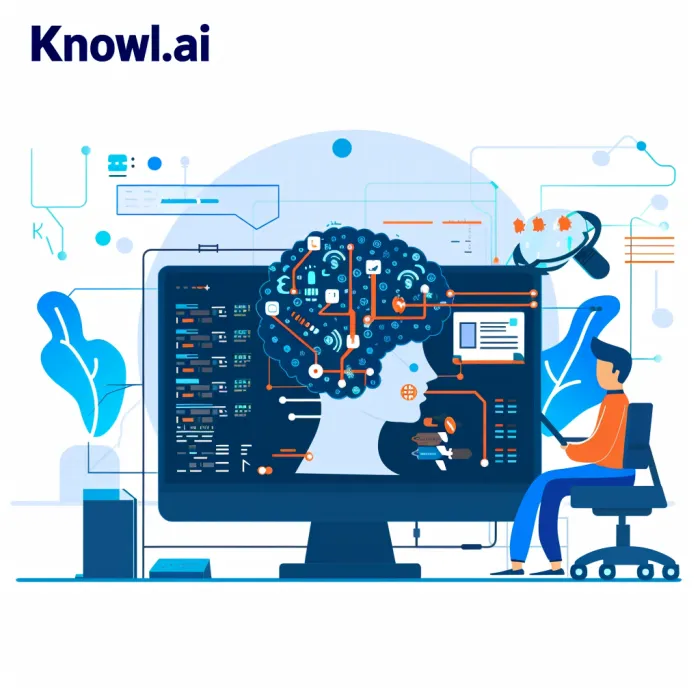Understanding the Basics of API-Driven CMS
What is an API-Driven CMS?
An API-driven CMS, often synonymous with "headless" or "decoupled" CMS, focuses on content management and delivery through APIs. Unlike traditional CMS platforms, where content management and presentation are tightly interwoven, an API-driven CMS separates the backend (where content is stored and managed) from the frontend (where content is presented). This separation allows developers to use APIs to fetch and display content across various platforms without being limited by the CMS's frontend capabilities.
Key Takeaway: An API-driven CMS offers unparalleled flexibility in content management and delivery, catering to a multi-platform digital environment.
How Does API-First Approach Benefit Content Management?
Adopting an API-first approach in content management systems means prioritizing the development of the API from the outset of the project. This strategy ensures that the CMS is built with scalability, flexibility, and integration in mind. For content managers and marketers, this translates to being able to distribute content across various channels—from web and mobile apps to IoT devices—seamlessly. For developers, it means easier integrations and the freedom to choose the best tools for the frontend.
Key Takeaway: An API-first approach enhances content distribution capabilities and simplifies integration with other systems and platforms.
Integrating APIs into Traditional CMS Platforms
While traditional CMS platforms like WordPress dominate the web, integrating APIs into these systems can breathe new life into them. By leveraging APIs, traditional CMSs can serve headless capabilities, allowing content to be managed within the familiar CMS interface while being delivered through modern frontend technologies. This hybrid approach can offer the best of both worlds: the robust content management features of traditional CMSs with the flexibility and scalability provided by API-driven architectures.
Key Takeaway: Integrating APIs into traditional CMS platforms enables them to adopt the flexibility of headless architecture without completely abandoning their core functionalities.
Exploring the Functionality of API-First CMS
How Does an API-First CMS Work?
An API-first CMS operates on the principle of serving content as data over APIs, which can then be fetched and displayed by any frontend system. This model decouples content management from content delivery, enabling developers to use modern frontend technologies like React or Angular to create dynamic, user-centric experiences. The CMS essentially becomes a content repository accessible via API calls, making it easier to manage and deliver content across multiple channels.
Key Takeaway: An API-first CMS simplifies content delivery across diverse platforms, allowing for the creation of dynamic digital experiences.
Benefits of Using an API-First CMS
The shift to an API-first CMS offers numerous advantages:
Omnichannel Delivery: Content can be delivered across web, mobile, IoT devices, and beyond, ensuring a consistent digital experience.
Development Agility: Developers can work on the frontend independently of the backend, reducing development time and facilitating a faster go-to-market strategy.
Future-proofing: Easily integrate with new technologies and platforms as they emerge, keeping your digital experiences at the cutting edge.
Key Takeaway: Adopting an API-first CMS positions organizations to rapidly adapt to changing digital landscapes, ensuring agility and continued relevance.
Key Differences Between API-First CMS and Traditional CMS
The primary difference between API-first CMS and traditional CMS lies in their architecture. Traditional CMSs are monolithic, combining content management and presentation in a single platform, often leading to limitations in how and where content can be delivered. API-first CMSs, by contrast, offer a headless architecture that separates content management from delivery, providing unparalleled flexibility in how content is utilized and presented across various digital channels.
Key Takeaway: The separation of concerns in API-first CMS offers greater flexibility and efficiency over traditional CMS, paving the way for innovative content delivery solutions.

Fun Fact: Headless CMS
The term "headless CMSs" is inspired by the concept of "decapitating" the presentation layer from the content management backend, emphasizing the separation of content management and content delivery.
Implementing API-Driven CMS for Developers and Marketers
In today's dynamic web ecosystem, API-driven CMS is reshaping how content is managed, bridging the gap between developers and marketers with efficiency and flexibility.
How Developers Benefit from API-Driven CMS
API-driven CMS platforms empower developers by decoupling the backend content management from the frontend presentation layer. This separation allows developers to work in their preferred tools and frameworks, reducing the time and complexity involved in deploying updates or new features. With the ability to make API calls to fetch or submit content, developers can automate workflows, leading to a more streamlined development process. This approach not only enhances productivity but also enables developers to focus on creating engaging user experiences without being bogged down by the intricacies of content management.
Key Takeaway: API-driven CMS allows developers to leverage automation and their preferred tools, enhancing productivity and focus on user experience.
The Role of API-Driven CMS in Enabling Marketers
For marketers, an API-driven CMS represents agility and the power to disseminate content across various channels effortlessly. By separating the content management from the delivery mechanism, marketers gain the freedom to update content in real-time without dependency on development resources. This capability ensures that marketing campaigns can be more reactive to the market dynamics, improving engagement and conversion rates. Additionally, it offers marketers the tools to understand content performance through integrated analytics, making data-driven decisions easier and more effective.
Key Takeaway: API-driven CMS empowers marketers with the agility to update content in real-time across multiple channels, enhancing campaign effectiveness.
Enhancing User Experience with API-Driven Content
The core advantage of API-driven content lies in its ability to provide a cohesive user experience across all digital touchpoints. By leveraging APIs, content can be tailored and served to various platforms (websites, mobile apps, IoT devices) in the most optimal format, ensuring a seamless and engaging user interaction. This approach also facilitates personalization at scale, allowing marketers to deliver content that resonates with individual user preferences, significantly improving user satisfaction and loyalty.
Key Takeaway: API-driven content facilitates a seamless and personalized user experience across multiple platforms, enhancing engagement and loyalty.
Choosing the Best API-First CMS for Your Needs
Selecting the right API-first CMS is crucial for aligning with your organization's goals, offering scalability, flexibility, and ease of integration for developers and marketers.
Factors to Consider When Selecting an API-First CMS
When choosing an API-first CMS, consider factors such as support for RESTful and GraphQL APIs, compatibility with existing tech stacks, and the ease of content management for non-technical users. The platform's scalability, security features, and the community or vendor support available are also critical. An API-first CMS that aligns with these factors can significantly reduce development time, foster collaboration between teams, and enhance overall content strategy effectiveness.
Key Takeaway: Carefully evaluate API support, tech stack compatibility, scalability, and security when selecting an API-first CMS to ensure it meets organizational needs.
Comparing Different API-First CMS Platforms
While comparing API-first CMS platforms, look beyond the basic features to assess how each platform supports content delivery across various channels, integrates with other tools, and manages content workflows. Consider the platform's approach to content modeling, extensibility, and how it handles content versioning and rollback. Reviews from similar-sized businesses and industry use cases can provide insights into how a platform performs under real-world conditions, guiding you to a more informed decision.
Key Takeaway: Compare API-first CMS platforms based on content delivery capabilities, integration ease, and real-world performance to find the best fit.
Why Marketers and Developers Choose API-First CMS Solutions
Marketers and developers prefer API-first CMS solutions for their flexibility in content management and delivery, enabling faster deployment of digital experiences. These platforms cater to the needs of both groups by allowing marketers to manage content independently while giving developers the freedom to build innovative front-end experiences. The result is a more agile, collaborative, and effective content strategy that drives engagement and growth.
Key Takeaway: API-first CMS solutions offer the flexibility, independence, and collaboration that marketers and developers need to drive successful digital experiences.

Optimizing Content Management with API-Driven Approach
In the ever-evolving digital landscape, the way we manage, deliver, and interact with content is undergoing a revolutionary change. The shift towards an API-driven approach in content management systems (CMS) is not just a trend; it's a response to the growing need for agility, flexibility, and scalability in digital experiences. This section dives into how leveraging APIs, particularly GraphQL and Git-based systems, enhances content management and fosters collaboration between developers and content creators. Let’s unravel the magic behind the scenes, where code meets content in a seamless dance of innovation.
Leveraging GraphQL APIs for Improved Content Delivery
GraphQL APIs have become a game-changer in the world of API-driven CMS by offering more efficient ways to query and manipulate data. Unlike traditional REST APIs, GraphQL allows clients to request exactly the data they need, reducing the amount of data transferred over the network. This efficiency is particularly beneficial for content delivery across multiple platforms, where performance and loading times are crucial. By adopting a GraphQL API, developers can create more responsive, faster-loading applications, ensuring a smoother user experience. This approach not only saves valuable development time but also significantly improves the end-user experience by delivering content more effectively.
Key Takeaway: GraphQL APIs streamline content delivery by allowing precise data queries, enhancing application performance, and improving user experiences.
Managing Content Seamlessly with Git-Based CMS
Git-based CMS represents a paradigm shift in content management, emphasizing version control and collaboration. By integrating directly with Git repositories, these systems enable content creators and developers to work together more efficiently. Every change to the content is tracked, allowing teams to easily roll back to previous versions and understand the evolution of their content. This seamless integration with Git supports a more collaborative and controlled approach to content management, making it easier to maintain consistency and quality across digital properties. For developers and content editors, the benefits are clear: a more transparent, accessible, and manageable content workflow.
Key Takeaway: Git-based CMS harnesses the power of version control for content management, enhancing collaboration and efficiency in digital content creation and maintenance.
Enhancing Collaboration Between Content Creators and Developers
The gap between content creators and developers has long been a challenge in the digital content ecosystem. However, the rise of API-driven CMS solutions bridges this divide, fostering a more collaborative environment. By abstracting the backend content management from the frontend presentation layer, API-first CMS enables content creators to make changes independently, without needing to understand the underlying code. Simultaneously, developers can focus on building and optimizing the user experience, confident that content updates will seamlessly integrate without breaking the site. This symbiotic relationship enhances the agility of content strategies and the deployment of digital experiences, leading to more dynamic, relevant, and engaging web properties.
Key Takeaway: API-driven CMS fosters a collaborative environment where content creators and developers work more efficiently, leading to faster content updates and improved digital experiences.
FAQs:
Can I use an API-driven CMS with existing digital platforms?
Yes, the flexibility of API-driven CMS allows it to integrate seamlessly with existing platforms, enhancing their capabilities without the need for a complete overhaul.Is moving to an API-first CMS a complex process?
Transitioning can vary in complexity based on the existing setup. However, the long-term benefits of flexibility, scalability, and improved user experience often outweigh the initial effort.
About Knowl.io
Introducing Knowl.io, the revolutionary AI-driven platform designed to transform how API documentation is created and maintained. Say goodbye to the painstaking process of manually updating specifications with each code change—Knowl.io does the heavy lifting for you. With seamless integration into your development workflow, Knowl.io ensures your API documentation is perpetually accurate, reflecting the latest updates in your codebase without the need for manual annotations or explanations.
At the heart of Knowl.io is cutting-edge AI technology that meticulously identifies endpoints, parameters, and behaviors, crafting detailed and up-to-date API documentation with comprehensive explanations. Trust Knowl.io to elevate your documentation process, making it more efficient and reliable than ever. Ensure your developers and stakeholders always have access to the most current and coherent API documentation with Knowl.io, where innovation meets simplicity.


